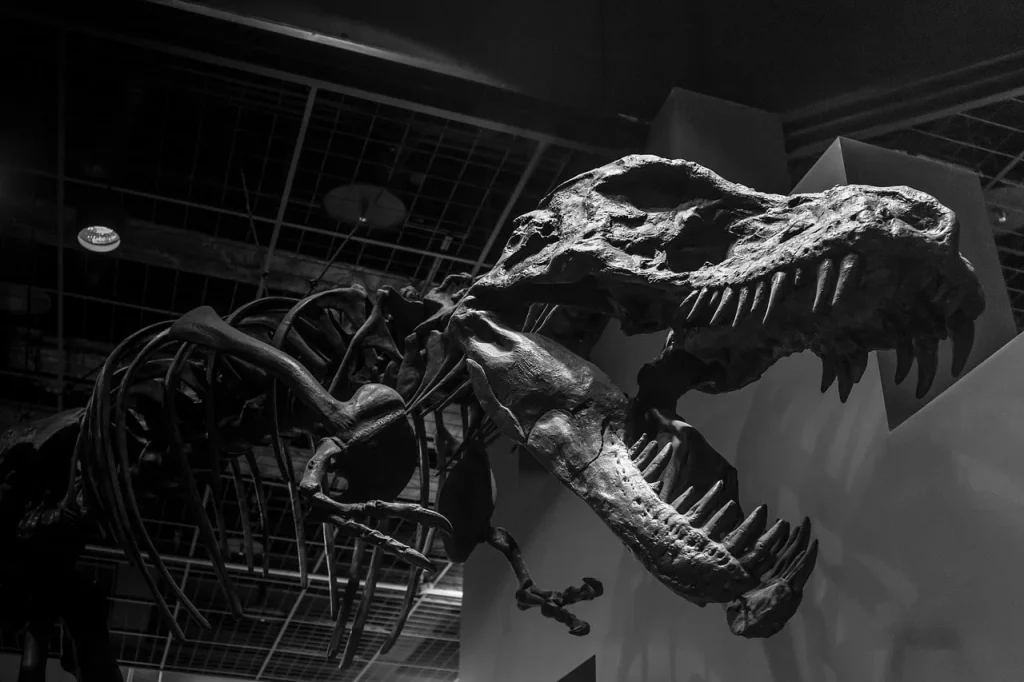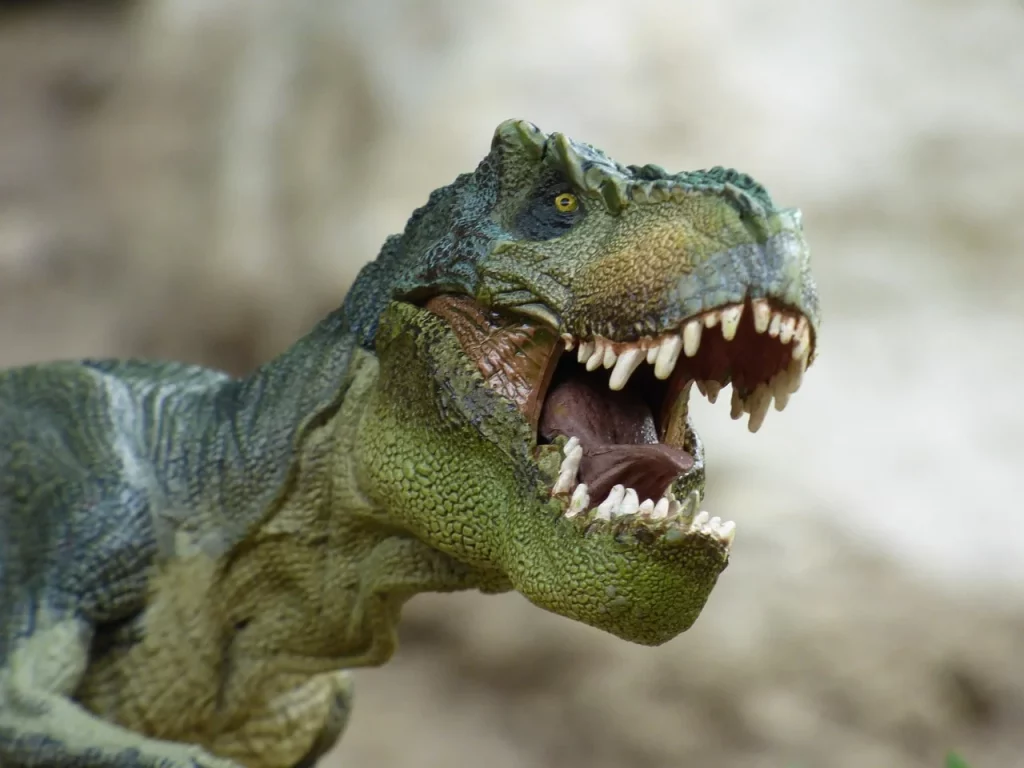Have you ever gazed up at the vast night sky and wondered about the incredible creatures that roamed the Earth millions of years ago? Dinosaurs, the majestic rulers of the prehistoric world, continue to captivate our imaginations and challenge our understanding of the past.
In this exploration of fascinating dinosaur facts, we’ll embark on a journey through time, uncovering the secrets of these magnificent beasts. From the gigantic Brachiosaurus to the fierce Tyrannosaurus rex, prepare to be amazed by the diverse and astonishing world of dinosaurs.
The great extinction that wiped out the dinosaurs was a pivotal moment in Earth’s history.
Stephen Jay Gould
Dinosaur Facts
Embark on a journey back in time as we uncover many cool facts about dinosaurs. Your attention to detail will be crucial, as I created a quiz at the article’s end to test your knowledge and see if you are a true dinosaur expert.
- Dinosaurs first emerged about 230 million years ago, during the Mesozoic Era.
- The term “dinosaur,” meaning “terrible lizard,” was first used by Sir Richard Owen in 1842.
- The Tyrannosaurus rex possessed a bite force roughly equal to an adult elephant’s weight, around 12,800 pounds.
- Contrary to popular belief, Velociraptors were about the size of turkeys, much smaller than their cinematic portrayals.
- The Stegosaurus had a brain comparable in size to a walnut, notably small for its large body.
- The Spinosaurus, bigger than the T. rex, is the largest known meat-eating dinosaur.
- Dinosaurs inhabited every continent, including Antarctica.
- The Argentinosaurus, measuring over 100 feet, was the longest dinosaur.
- The Brachiosaurus could raise its head over 40 feet high, similar to a four-story building’s height.
- Dinosaurs are categorized into two groups based on their hip structure: Saurischia (“lizard-hipped”) and Ornithischia (“bird-hipped”).
- A Triceratops could have 400 to 800 teeth throughout its lifetime.
- The majority of dinosaurs were plant-eaters, not meat-eaters.
- The smallest known dinosaur, the Compsognathus, was about the size of a chicken.

- The Dinosauria group is known for hollow bones and three primary limb bones.
- Recent fossil findings suggest that dinosaurs may have had feathers in addition to scales.
- The fastest dinosaurs, like the Ornithomimids, could reach speeds up to 70 km/h.
- The Carnotaurus had remarkably short arms, even shorter than those of the T. rex.
- Pterosaurs, a separate group from dinosaurs, were flying reptiles.
- The Oviraptor, named for being found near eggs, may not have been an egg thief as its name suggests.
- The Theropods, a subgroup of dinosaurs, were predominantly carnivorous, including species like T. rex and Velociraptor.
- Herbivorous dinosaurs had varied teeth shapes, suitable for grinding plants or slicing leaves.
- The Ankylosaurus used its club-like tail for defense.
- The Iguanodon, discovered in the early 19th century, was among the first recognized dinosaurs.
- The Parasaurolophus had a long, curved crest possibly used for sound production or display.
- Sauropods swallowed stones to grind plant material in their stomachs, as they couldn’t chew.
- The portrayal of Velociraptors in the “Jurassic Park” series was inspired by the Deinonychus.
- The Archaeopteryx represents a crucial link between dinosaurs and birds.
- Hadrosaurs, known as “duck-billed dinosaurs,” had numerous teeth adapted for tough plant material.

- Dinosaur eggs varied in shape and size, with some as big as basketballs.
- Dinosaurs like the Protoceratops may have lived in herds.
- The Dimetrodon, often mistaken for a dinosaur, actually predates them and is closer to mammals.
- Dinosaur skin impressions reveal scales and sometimes color patterns.
- The Giganotosaurus, another massive carnivore, rivaled the T. rex in size.
- The first scientifically described dinosaur fossil was that of Megalosaurus, in 1824.
- About 65 million years ago, dinosaurs suffered a mass extinction, likely due to an asteroid impact and volcanic eruptions.
- The Microceratus, one of the smallest dinosaurs, was about the size of a rabbit.
- The Therizinosaurus had the longest dinosaur claws, reaching up to 1 meter.
- The Pachycephalosaurus had a thick, bony skull, possibly for head-butting or display.

- The Sinosauropteryx, a small carnivore, was among the first dinosaurs discovered with feather-like structures.
- The Coelophysis, a slender and agile dinosaur, lived during the late Triassic period.
- The Allosaurus, a large predator, may have hunted in groups.
- The Yutyrannus, related to T. rex, had a feathered coat.
- Dinosaur fossils have been discovered on every continent, including Antarctica.
- The Stegosaurus had distinctive large bony plates along its back.
- The Mosasaurus, an aquatic lizard from the dinosaur era, was not a dinosaur.
- The Apatosaurus was once incorrectly called Brontosaurus due to a naming error.
- The Kentrosaurus, a Stegosaurus relative, had defensive body spikes.
- The Diplodocus could whip its tail at sonic speeds, possibly for defense or signaling.
- The Utahraptor is the largest known raptor species.
- The Sauroposeidon could reach heights up to 60 feet, among the tallest dinosaurs.
Dinosaur Myths

Let’s transition from the weird facts about dinosaurs to the myths, like a paleontologist sifting through layers of earth, seeking the truth. Let’s find out the actual truth behind these common myths.
- Dinosaurs All Lived at the Same Time
They existed over a vast period, spanning approximately 165 million years. Different species lived and became extinct at various times. For example, the famous Tyrannosaurus rex and Stegosaurus were separated by around 85 million years! - All Dinosaurs Were Huge
Not all dinosaurs were towering giants. Many were quite small. The Microraptor, for instance, was about the size of a modern crow. Diversity in size was as common among dinosaurs as it is in today’s animals. - Dinosaurs Were All Ferocious Predators
While some dinosaurs were fearsome predators, many were actually herbivores, like the Triceratops. Others were omnivores. Their diets were as varied as their sizes! - Dinosaurs Could Only Live on Land
While most dinosaurs were land-dwellers, there were species adapted to aquatic environments, like Spinosaurus, which likely spent a lot of time in water, similar to modern crocodiles. - The Asteroid Impact Was the Sole Cause of Dinosaur Extinction
The asteroid impact was a major factor, but it’s believed that various other factors, like volcanic activity and climate change, also contributed to the gradual decline and eventual extinction of the dinosaurs.
No products found.
Dinosaur Quotes

The world of dinosaurs is shrouded in mystery and wonder. Below is a list of my favorite quotes about them. Let me know yours in the comments so I can add them to the list.
Dinosaurs may be extinct from the face of the planet, but they are alive and well in our imaginations.
Steve Miller
This quote by Steve Miller, highlights the enduring fascination and presence of dinosaurs in human culture and imagination.
The history of life is not necessarily progressive; it is certainly not predictable. The earth’s creatures have evolved through a series of contingent and fortuitous events.
Stephen Jay Gould
This quote by Stephen Jay Gould, emphasizes the unpredictability and contingency of evolutionary history, including the evolution of dinosaurs.
To a canary, a cat is a monster. We’re just used to being the cat.
Douglas Adams
This quote by Douglas Adams, offers a perspective on the relative nature of what we consider monstrous, referencing the scale of dinosaurs compared to humans.
I wanted to be a paleontologist, but then I realized they were all covered in dust.
Robin Williams
This humorous quote by Robin Williams, reflects on the childhood dream of becoming a paleontologist, only to be deterred by the reality of the job.
Dinosaurs are the jumping off point for the imagination.
Barbara Boxer
This quote by Barbara Boxer, captures the idea that dinosaurs serve as a catalyst for human creativity and imagination.
Dinosaur FAQ

We’re getting near the end of our dinosaur exploration, and just before you tackle the quiz, here’s the FAQ section. It’s your last opportunity to fill in any gaps in your dino knowledge.
- Are dinosaurs real?
Dinosaurs were real creatures that lived millions of years ago. They roamed the Earth during a period known as the Mesozoic Era, which lasted from about 252 to 66 million years ago. This era is divided into three periods: the Triassic, Jurassic, and Cretaceous. Evidence of their existence is found in fossils – the preserved remains or impressions left in rock. - Which dinosaurs evolved into birds?
The dinosaurs that evolved into birds were a group called theropods. This group included the famous Tyrannosaurus rex and smaller dinosaurs like Velociraptor. The most direct ancestors of birds are believed to be a subgroup of theropods called maniraptors. Over millions of years, these creatures evolved to develop feathers, wings, and other bird-like characteristics. Today, birds are considered living dinosaurs! - Can dinosaurs be cloned?
As of now, cloning dinosaurs is not possible. The main reason is the lack of viable dinosaur DNA. DNA degrades over time, and the youngest dinosaur fossils are about 66 million years old, far too old for DNA to survive. Even if we could retrieve DNA, the process of cloning would require a closely related living species to act as a surrogate, and there’s no close match for dinosaurs today. - Are dinosaurs mentioned in the Bible?
Dinosaurs are not explicitly mentioned in the Bible. The Bible was written long after dinosaurs had become extinct, and the concept of dinosaurs as we understand it today wasn’t developed until the 19th century when the first dinosaur fossils were scientifically described. Some people interpret certain biblical creatures like “Leviathan” or “Behemoth” as possibly being dinosaurs, but these are speculative interpretations. - How did dinosaurs go extinct?
The most widely accepted theory is that dinosaurs went extinct due to a catastrophic asteroid impact about 66 million years ago. This event is known as the Cretaceous-Paleogene (K-Pg) extinction event. The impact would have triggered massive environmental changes like tsunamis, wildfires, and a “nuclear winter” effect that drastically cooled the Earth. This catastrophic event made it difficult for dinosaurs to survive, leading to their extinction.
No products found.
Dinosaur Trivia

Get ready to roar into our dinosaur quiz! But be warned, score zero, and you’ll be humorously teleported to the Mesozoic Era as a snack for a hungry velociraptor!
Conclusion
Our journey among these ancient giants comes to an end, but their echo resonates in every fossil and footprint left behind. Dinosaurs are a testament to the Earth’s incredible ability to foster life in myriad forms.
How do you think our current ecosystems compare to those of the dinosaurs? And, just for a chuckle, if dinosaurs could talk, what do you think a T-Rex would say about its tiny arms? Let me know in the comments.
8 Sources Used For This ArticleAre all fossil animals dinosaurs? – Science News
Dinosaur – Kids Britannica
25 Most Popular and Famous Dinosaurs – Gage Beasley Prehistoric
Dinosaur Questions – Enchanted Learning
When Were Dinosaurs Discovered? – Out Foria
43 Interesting Dinosaur Facts – Isolated Traveller
Dino Facts – The Dino Saur Museum


